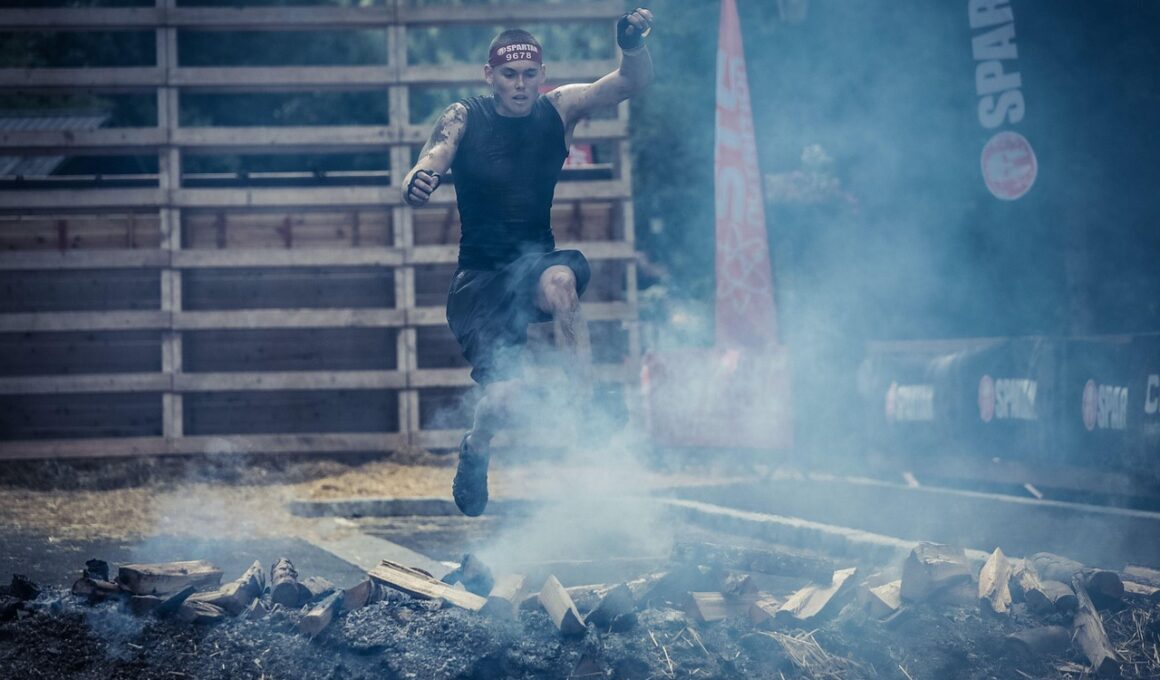The Future of Smart Footwear in Obstacle Course Racing
Obstacle Course Racing (OCR) has surged in popularity, leading to innovation in the sport. A significant focus has shifted towards footwear technology, crucial for enhancing performance and safety. Traditional running shoes can struggle with terrains like mud, water, and varying obstacles. This creates a need for smarter footwear equipped with advanced technology. Smart footwear is designed to offer superior grip and durability, adapting to different conditions without compromising comfort. With features like moisture control and enhanced breathability, runners can maintain optimal foot conditions despite challenging environments. OCR footwear utilizes lightweight materials that provide both agility and support. Additionally, incorporating dynamic cushioning can help absorb shock from jumps and landings. Data analysis has become key in development, leading to products tailored to individual needs. Furthermore, customization options for fit and style are becoming increasingly available, allowing athletes to personalize their footwear, leading to better performance. As new innovations are explored, the future of OCR shoes seems bright, blending technology with sport-specific requirements. The combination of these elements will redefine how athletes approach obstacle courses, improving their overall experience and success rate.
The rising trends in footwear technology also focus on energy return. Many smart footwear designs now incorporate responsive materials that capture and store energy during runs. For OCR athletes, this means improved efficiency while navigating challenging terrains. This type of footwear allows the runner to harness their energy, providing a slight spring, which enhances speed and reduces fatigue. Performance metrics become measurable, aligning with wearable tech, making it easier for participants to analyze their performance. Some brands are adopting artificial intelligence to gather data from each run, offering tailored advice for improvements. Additionally, the integration of GPS tracking enhances the safety aspect of navigation through various racecourses. Runners can monitor distances and even receive feedback on their running styles right in real-time. Another exciting development is the use of 3D printing, enabling quick prototyping and a more personalized fit. This technology allows for experimentation with designs, encouraging creativity. As innovation continues, the footwear will become a vital tool in transforming the OCR experience, effectively eliminating barriers while introducing fresh challenges. Athletes can rely on their footwear technology as both a partner and a guide.
Sustainability in Smart OCR Footwear
As the sport evolves, there’s also a significant push toward sustainability within the production of smart footwear. Environmentally friendly materials and sustainable practices are becoming expectations rather than novelties in performance products. Innovations now utilize biodegradable components and recycled materials, reducing the ecological footprint left by such gear. Footwear brands are beginning to embrace circular economy principles, designing shoes meant to be repaired, reused, or recycled. This not only appeals to environmentally conscious consumers but also encourages longevity in footwear products. Transparency in sourcing and labor practices has become more prevalent in recent years, with many companies highlighting their sustainability commitments. By investing in eco-friendly manufacturing processes, brands can help solve broader issues such as pollution and waste. Furthermore, sustainable options do not compromise performance; some materials even enhance comfort and functionality. Athletes appreciate a shoe that aligns with their values while delivering superior results. As awareness of climate change grows, the value of sustainable footwear will revolutionize viewing performance, leading consumers to choose ethically sourced equipment. The relationship between OCR and sustainability continues to strengthen, showcasing responsibility within the racing community.
Incorporating technology doesn’t end with performance. Enhanced safety measures are crucial in OCR, where unpredictable challenges can arise. Smart footwear is being developed with features like anti-slip soles and reinforced toe caps, which are imperative for avoiding injuries. These innovations aim to reduce accidents and empower athletes to conquer obstacles confidently. With real-time feedback, runners can adjust their foot placement on the fly, significantly improving their navigation through tougher terrains. Alongside physical safety, there’s also mental assurance, knowing their equipment can be relied upon. Furthermore, brands are partnering with medical experts to design footwear that promotes foot health, preventing injuries like plantar fasciitis or blisters. By ensuring optimal fit and support, athletes can focus on the race rather than their feet. Brands are utilizing user feedback to create shoes that address common concerns, making them allies in the race. As technology advances, the integration of smart sensors could help in injury prevention, providing alerts when the runner’s form begins to falter. The future of OCR footwear combines performance with safety, turning them into essential gear for both casual and competitive athletes.
The Role of Data and Analytics
Data analytics is becoming a game-changer for athletes in the realm of OCR. The ability to collect, analyze, and apply performance data has never been more critical. Smart footwear can track metrics such as speed, stride length, and foot placement, providing insights toward optimizing performance. Users can leverage this information to address weaknesses in their technique or endurance levels. This data-driven approach enhances training regimens and fosters informed decision-making. Coaches can also utilize data to create personalized programs to guide athletes through their journey. Sharing results through mobile applications enables runners to set goals and track their progress over time. These innovations create a community among racers, allowing athletes to compete against others virtually or share experiences with fellow participants. As fitness wearables continue to evolve, enhancing smart footwear will become a leading trend in the sport. The fusion of these technologies amplifies the experience of OCR, enabling sports enthusiasts to embrace a more informative approach. This shift is inspiring a generation of athletes who thrive on measurable progress and continuous improvement in their fitness journeys.
Training facilities specializing in OCR are starting to recognize the need for advanced footwear as part of their offerings. Facilities want athletes to have the best resources available to prepare for competitions. Hence, they often work with brands to demonstrate cutting-edge footwear technology, providing potential users an opportunity to test various models. Workshops can also educate participants on how to select footwear suited for their specific needs and abilities. Knowledge-sharing is becoming a core aspect of training. Moreover, having facilities equipped with technology that connects to footwear can assist athletes in assessing their capabilities in controlled environments. This experimentation can lead to better performance on race day, offering runners strategic advantages. The combination of clever footwear choices paired with dedicated training regimens can elevate an athlete’s game significantly. These collaborations signal an exciting time for OCR, as partnerships between creators and trainers flourish. A collaborative culture paves the way for shared knowledge, enhancing everyone’s experience. Observing the outcomes tied to innovative footwear in training settings will contribute valuable insights to the overall development of the sport.
Conclusion: Future Outlook
The convergence of technology and sport reveals exciting prospects for obstacle course racing. Future footwear designs are positioned to embrace technological advancements that enhance performance and safety while advocating for sustainability. Athletes today are full of excitement as they step into a future where every detail of their footwear is tailor-made for their needs. With innovations like data analytics and smart materials serving as foundations, the era of advanced OCR footwear is upon us. Both amateur competitors and seasoned veterans can expect customized experiences from their gear that aligns more closely with their passions. Brands eager to engage with consumers will build strong relationships by understanding their vital role in everyday training and performance. As the sport grows, the continued development of smart footwear will reveal new heights in racing capabilities. In summary, it is an exhilarating time to be involved in OCR, where every step takes individuals closer to ambitious goals. We anticipate that the next generation of smart footwear will revolutionize how athletes approach obstacle races, creating an engaging and competitive sporting atmosphere.
As technology grows, athletes will benefit from responsive designs, offering insights to perfect their performance. Through these innovations, OCR continues to evolve, keeping pace with the demands of athletes striving for excellence. The link between smart footwear and athlete performance underscores a transformative period in the sport.


